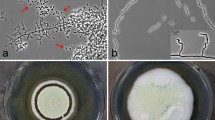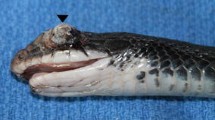Abstract
Mortality as a direct result of venomous snake bites is estimated to be in the thousands worldwide per year. However, while venom may be the primary mortality vector, snake oral cavities can also contain significant pathogens capable of causing infection in bite victims. This study was conducted to identify potentially pathogenic fungal flora in the oral cavities of venomous and non-venomous snakes. Sterile swabs were used to retrieve samples from the oral cavities of different snakes followed by medium-specific culture. Slide culture technology was also used in the identification of fungal flora. Rhizopus and Mucor represented the most common fungal flora each making up 29 % of the total. Alternaria, Cladosporium, Aspergillus and Candida represented a significantly smaller portion of fungal pathogen load at around 3 % each. Fungi, Yeast (19.4 %) and Penicillium (9.7 %), were also identified in the retrieved samples. Our results indicate that both venomous and non-venomous snakes carry a significant fungal pathogenic load in their oral cavities. Therefore, fungal infection should be considered, in addition to toxicity, especially in snake bite victims with immune deficiency.
Similar content being viewed by others
References
Ainsworth, G. C. (2008). Ainsworth & Bisby’s dictionary of the fungi, Cabi
Alirol E, Sharma SK, Bawaskar HS, Kuch U, Chappuis F (2010) Snake bite in South Asia: a review. PLoS Negl Trop Dis 4(1):e603
Bawaskar H, Bawaskar P (2002) Profile of snakebite envenoming in western Maharashtra, India. Trans R Soc Trop Med Hyg 96(1):79–84
Blaylock R (2001) Normal oral bacteria flora from some southern African snakes. The Onderstepoort journal of veterinary research 68(3):175
Chinn R, Diamond RD (1982) Generation of chemotactic factors by Rhizopus oryzae in the presence and absence of serum: relationship to hyphal damage mediated by human neutrophils and effects of hyperglycemia and ketoacidosis. Infect Immun 38(3):1123–1129
Cooper J, Leakey J (1976) A septicaemic disease of East African snakes associated with enterobacteriaceae. Trans R Soc Trop Med Hyg 70(1):80–84
Cruz LS, Vargas R, Lopes AA (2009) Snakebite envenomation and death in the developing world. Ethnicity & Disease 19(1):42
Dehghani R (2011) Health pests and safe control methods of them. Publications of Farmanesh and Kashan University of Medical Sciences, pp 39–44
Dehghani R, Rabani D, Shahi MP, Jazayeri M, Bidgoli MS (2012) Incidence of snake bites in Kashan, Iran during an eight year period (2004-2011). Archives of trauma research 1(2):67
Dehghani R, Dadpour B, Mehrpour O (2014a) Epidemiological profile of snakebite in Iran, 2009-2010 based on information of Ministry of Health and Medical Education. International Journal of Medical Toxicology and Forensic Medicine 4(2 (Spring)):33–41
Dehghani R, Fathi B, Shahi MP, Jazayeri M (2014b) Ten years of snakebites in Iran. Toxicon 90:291–298
Dehghani R, Mehrpour O, Shahi MP, Jazayeri M, Karrari P, Keyler D, Zamani N (2014c) Epidemiology of venomous and semi-venomous snakebites (Ophidia: Viperidae, Colubridae) in the Kashan city of the Isfahan province in Central Iran. Journal of research in medical sciences: the official journal of Isfahan University of Medical Sciences 19(1):33
Dehghani R, Sharif MR, Moniri R, Sharif A, Kashani HH (2016) The identification of bacterial flora in oral cavity of snakes. Comp Clin Pathol 25(2):279–283
Fonseca MG, Moreira W, Cunha K, Ribeiro A, Almeida M (2009) Oral microbiota of Brazilian captive snakes. Journal of Venomous Animals and Toxins including Tropical Diseases 15(1):54–60
Guardia JA, Bourgoignie J, Diego J (2000) Renal mucormycosis in the HIV patient. Am J Kidney Dis 35(5):e24. 21–e24. 25
Hejnar P, Bardoň J, Sauer P, Kolář M (2007) Stenotrophomonas maltophilia as a part of normal oral bacterial flora in captive snakes and its susceptibility to antibiotics. Vet Microbiol 121(3):357–362
Huang L-W, Wang J-D, Huang J-A, Hu S-Y, Wang L-M, Tsan Y-T (2012) Wound infections secondary to snakebite in central Taiwan. Journal of Venomous Animals and Toxins including Tropical Diseases 18(3):272–276
Hurley R, De Louvois J, Mulhall A (1987) Yeasts as human and animal pathogens. The yeasts 1:207–281
James WD, T Berger and D Elston (2015) Andrews’ diseases of the skin: clinical dermatology, Elsevier Health Sciences
Jorge M, Nishioka SDA, De Oliveira R, Ribeiro L, Silveira P (1998) Aeromonas hydrophila soft-tissue infection as a complication of snake bite: report of three cases. Ann Trop Med Parasitol 92(2):213–217
Kouadio, I. K., S. Aljunid, T. Kamigaki, K. Hammad and H. Oshitani (2012) Infectious diseases following natural disasters: prevention and control measures
Kurtzman CP, Fell JW (2006) Yeast systematics and phylogeny—implications of molecular identification methods for studies in ecology, Biodiversity and Ecophysiology of Yeasts. Springer, Berlin Heidelberg New York, pp. 11–30
Kurtzman CP, Piškur J (2006) Taxonomy and phylogenetic diversity among the yeasts. Springer, Berlin Heidelberg New York
Lam KK, Crow P, Ng KH, Shek KC, Fung HT, Ades G, Grioni A, Tan KS, Yip KT, Lung DC, Que TL, Lam TS, Simpson ID, Tsui KL, Kam CW (2011) A cross-sectional survey of snake oral bacterial flora from Hong Kong, SAR, China. Emerg Med J 28(2):107–114. doi:10.1136/emj.2009.086694
Latifi M (2000) The snakes of Iran. 3rd Persian Edition. Published by Environment Protection organization, Tehran
Luo L, Cheng D, Zhu H, Shu X, Chen W (2009) Inflammatory pseudotumoural endotracheal mucormycosis with cartilage damage. Eur Respir Rev 18(113):186–189
Manolakaki D, Velmahos G, Kourkoumpetis T, Chang Y, Alam HB, De Moya MM, Mylonakis E (2010) Candida infection and colonization among trauma patients. Virulence 1(5):367–375
Marques S, Robles A, Tortorano A, Tuculet M, Negroni R, Mendes R (2000) Mycoses associated with AIDS in the Third World. Med Mycol 38(sup1):269–279
Muma M, Chipalo-Mutati G (2010) Deadly orbital mucormycosis, rare yet possible infection. Medical Journal of Zambia 37(4):268–272
Nowicki M, Nowakowska M, Niezgoda A, Kozik E (2012) Alternaria black spot of crucifers: symptoms, importance of disease, and perspectives of resistance breeding. Vegetable Crops Research Bulletin 76:5–19
Pitt J, Basilico J, Abarca M, Lopez C (2000) Mycotoxins and toxigenic fungi. Med Mycol 38(s1):41–46
Roden MM, Zaoutis TE, Buchanan WL, Knudsen TA, Sarkisova TA, Schaufele RL, Sein M, Sein T, Chiou CC, Chu JH (2005) Epidemiology and outcome of zygomycosis: a review of 929 reported cases. Clin Infect Dis 41(5):634–653
Samson RA, Seifert KA, Kuijpers AF, Houbraken J, Frisvad JC (2004) Phylogenetic analysis of Penicillium subgenus Penicillium using partial β-tubulin sequences. Stud Mycol 49:175–200
Shek K, Tsui K, Lam K, Crow P, Ng K, Ades G, Yip K, Grioni A, Tan K, Lung DC (2009) Oral bacterial flora of the Chinese cobra (Naja atra) and bamboo pit viper (Trimeresurus albolabris) in Hong Kong SAR, China. Hong Kong Med J 15(3):183–190
Spellberg B, Edwards J, Ibrahim A (2005) Novel perspectives on mucormycosis: pathophysiology, presentation, and management. Clin Microbiol Rev 18(3):556–569
Stoyan T, Carbon J (2004) Inner kinetochore of the pathogenic yeast Candida glabrata. Eukaryotic cell 3(5):1154–1163
Tagwireyi DD, Ball DE, Nhachi CF (2001) Routine prophylactic antibiotic use in the management of snakebite. BMC Pharmacol Toxicol 1(1):4
Theakston R, Phillips R, Looareesuwan S, Echeverria P, Makin T, Warrell D (1990) Bacteriological studies of the venom and mouth cavities of wild Malayan pit vipers (Calloselasma rhodostoma) in southern Thailand. Trans R Soc Trop Med Hyg 84(6):875–879
Trape J-F, Pison G, Guyavarch E, Mane Y (2001) High mortality from snakebite in south-eastern Senegal. Trans R Soc Trop Med Hyg 95(4):420–423
Walker K, Skelton H, Smith K (2002) Cutaneous lesions showing giant yeast forms of Blastomyces dermatitidis. J Cutan Pathol 29(10):616–618
Weed HG (1993) Nonvenomous snakebite in Massachusetts: prophylactic antibiotics are unnecessary. Ann Emerg Med 22(2):220–224
Zare Mirakabadi, A. and S. Teimourzadeh (2008) Venomous snakes of Iran, prevention, first aids and treatment. Tehran: Teimourzadeh and Taieb
Zhang X-C, Visala A, Halme A, Linko P (1994) Functional state modelling approach for bioprocesses: local models for aerobic yeast growth processes. J Process Control 4(3):127–134
Zheng R-Y, Chen G-Q, Huang H, Liu X-Y (2007) A monograph of Rhizopus. Sydowia 59(2):273–372
Acknowledgment
We gratefully acknowledge the staffs of the laboratory research center of health environment at the Environment College of Kashan University of Medical Sciences especially Mr. Varasteh, Mr. Abdolahi, Mr. Hoseinkhah, Mr. Davari, and Mrs. Iranshahi and Mrs. Sedaqat. We also appreciate Mr. Asadi in Niasar health center for aiding us to collect and prepare the samples for the tests.
Author information
Authors and Affiliations
Corresponding author
Ethics declarations
Conflict of interest
The authors declared that they have no competing interests.
Rights and permissions
About this article
Cite this article
Dehghani, R., Sharif, A., Assadi, M. et al. Fungal flora in the mouth of venomous and non-venomous snakes. Comp Clin Pathol 25, 1207–1211 (2016). https://doi.org/10.1007/s00580-016-2330-1
Received:
Accepted:
Published:
Issue Date:
DOI: https://doi.org/10.1007/s00580-016-2330-1




